The Calendar of the Yearly Festivals
108 108 108 Utsuno Shrine
Shin-onsen Town Hamasaka

Picture of the Kirin’s Head
Picture of the Shoujou’s Mask
| Date of the Festival | Summer: ""Kawasuso Festival"" Sunday before the third Monday of July Autumn: October-8 |
|---|---|
| Time for the Kirin Dance at the Shrine | 7 a.m. and 7 p.m. |
| Origin | Mid-Edo period |
| Characteristics | Designated as an Important Intangible Cultural Property of Hyōgo Prefecture in 1972. The original Kirin head was crafted in 1817 and is still used in the dance today. |
| Area | Shin-onsen Town Hamasaka |
Introduction to the Shrine
Utsuno Shrine
According to the ridgepole sign remaining since the construction of the shrine, the Gozu-Tennō deity was transferred from Akasaka in Mitani district to the current location in Kanbun 2 (1662). The shrine was called “Gozu-Tennōkyū (Gion Shrine)” during the Edo period, and was renamed to "Utsuno Shrine" in Meiji 6 (1873).
■Deity of the Shrine
Ōkuninushi-no-Mikoto, Susanoo-no-Mikoto, Inadahime-no-Mikoto
■cultural property
[Kirin Dance]
Designated as a Hyōgo Prefecture Important Intangible Cultural Property in 1972.
Designated as a National Important Intangible Folk Cultural Property in 2020.
[The Kirin’s Head]
Designated as a Tangible Folk Cultural Property of Shin-onsen Town in 1985.
[Temperate Vegetation]
Designated as a Hyōgo Prefecture Natural Treasure in 1968.
[Kawasuso Festival and Togyo Parade]
Designated as an Intangible Folk Cultural Property of Shin-onsen Town in 1992.
[The Shrine's framed Nameplate]
Designated as a Tangible Cultural Property of Shin-onsen Town in 1995.
Access to the Shrine
Shin-onsen Town 2456-4, Mikata County, Hyōgo Prefecture(MAP)
A thirteen-minute walk from Hamasaka Station on the JR San'in Main Line.
Related Information
Sites Associated with the Kirin Dances
Monuments around the Tottori Station
-
Wooden Benches
-
Sand Sculpture of Kirin
-
Stone Sculpture of Kirin
-
Tottori Toshogu in the Ouchidani Park
Tottori Toshogu was established by Mitsunaka Ikeda, a local lord, in the 17th century, and is a branch shrine of Nikko Toshogu. The shrine inherits the initial Kirin, which is now stored in the Tottori Prefectural Museum. During Gongen Matsuri, a festival in October, members of the Inaba Kirin Dance Club dance before the shrine’s deity, and a procession of a mikoshi (portable shrine) walks through to animate the festival.
-
The Imeitei Pioneer Memorial Gallery of Hamasaka
Imeitei is a gallery remodeled by Shichikamaya Yashiki (Shichikamaya Mansion) of the Mori family, who until lately ran a sake-brewery. It is a historical and folk gallery where visitors can trace the footsteps of the pioneers living around the Shin-onsen Town. The head of the Kirin from the Utsuno Shrine is displayed in the gallery. It is designated as the town’s cultural heritage.
-
Sora no Eki Park (Sky Station Park) at the Amarube Bridge
The origin of the Kirin from the Junisha Shrine, a shrine in adjacent to the Yoroi district, is the Kirin dance performed in the Iwami Town. This dance was a part of the inauguration of the Amarube Bridge at the end of the Meiji period. Visitors can see children’s drawings of the Kirin displayed in Sora no Eki at the Amarube Bridge and the park at the foot of the Amarube Crystal Tower. The roadside stations in vicinity are also worth sightseeing.



